 |
Threesological (Three-patterned occurrences in Philosophical perspectives) Page IV |
 |
(The Study of Threes)
http://threesology.org
Divided? Trivided? nature of Humanity:
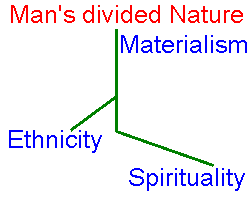 |
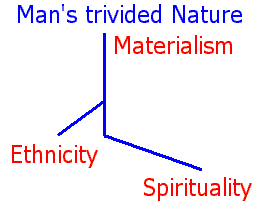 |
It may well be that the Tripartite Soul approach to insights into human nature can even be extended to a "Societal Level" of speculations about society and human existence. This view would suggest that Societies themselves have a Tripartite character:
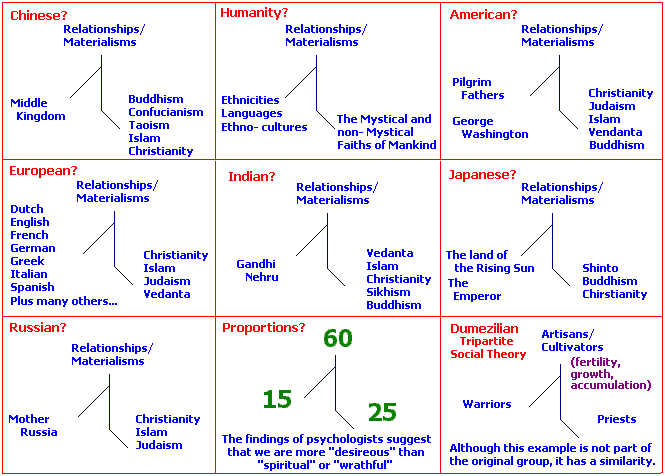
It cannot be denied that despite suggestions of a deep similarity in human nature across the Millennia and across the Globe there have been, for good and for ill, some notable "extreme?" personalities:
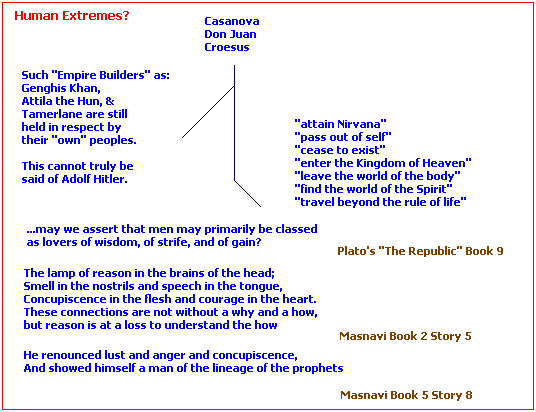
3-part introductory comments for Changing Mind.Com:
- Many people feel that we as humans, need to make some changes. We are unhappy with the present systems that we live in, but feel trapped, and therefore, we just continue on day-to-day. To most, it seems like too much of an uphill battle to accomplish anything that would even matter. And if you are willing to do something, where is the best place to begin?
- The fact is that humans have not always lived this way. In the hundreds of thousands of years that we have occupied this planet, we have only been living as a civilization for about the last ten thousand. What we are currently experiencing are the problems caused by a group of systems that are growing completely out of control. If we continue this way, we will devastate the world. We cannot go back, it's too late for that. But we must move ahead, to the next step, whatever it may be.
- "Defeat a thousand enemies and you still have a thousand enemies. Change a thousand minds and you have a thousand allies". Leverage is powerful. The leverage point for changing our systems starts with changing our minds about how we want things to be. History shows us that when enough minds are changed, the systems will also change.
3 groups within an environment where bullying takes place:
- Bully
- Victim
- Those who are neither victim nor bully, but may serve as bully, victim, or protector.
It is reported that bully and victim social roles tend to be relatively stable irrespective of changes in schools, teachers, classmates, and efforts by others to abolish bully and victim behaviors. In one report, children rated as bullies and victims in grade 6 retained these roles at a 3-year follow-up. By using the label "social roles," it may be of some value to look at the triad of Bullies - Victims- Intermediates from a Dumezilian tripartite view:
- Bully = equivalent in some ways with the Warrior/soldier role.
- Victim = equivalent in some ways with the passive herder/cultivator role (i.e. person who pays "taxes" such as money, food, homework, toy, sports equipment, pencils, crayons, desk, book, clothing item, right of way, etc., or relinquishes to punishment.
- Intermediate = Protector(intervention)/advisor/observer role.
3 to 1 ratio of the basis for the Bully- Victim- Intermediate triad:
- 1 of 3. Family/peer based
- 2 of 3. Environment/nutrition based
- 3 of 3. Genetic based
- 1 of 1. Combinations of the above three.
3 types of strategies used in school settings to address Bullying behavior:
- Punishment- (office referrals, withdrawal of recess, time-out booth, etc...)
- Teaching and Rewarding alternative behaviors- (social skills training, positive peer reporting, Modeling/imitation, etc...)
- Restrictions- (in-school suspension, expulsion, placement in alternative education environment, etc...)
Note: Each of these three strategies can be assessed time duration specificities:
- Punishment is usually of an immediate and short-term duration.
- Teaching and Rewarding is of a duration dependent on the student's ability to quickly learn (in a few days or slightly longer), to express more socially acceptable behavior. Thus, this strategy can be viewed as an intermediate-term duration.
- Restrictions may be several weeks, months, or longer, and is therefore easily identified as being of a long-term duration.
Tripartite Belief Model of Bullying Behavior:
- Normative beliefs- which refer to the individual's beliefs about the appropriateness of behavior, offer the direction that the individual will likely follow if s/he conjointly feels capable and motivated to do so. That is, one is more likely to carry out behavior that is consistent with one's beliefs about appropriateness.
- Self-efficacy beliefs- are perceptions about whether the behavior can be carried out successfully. These beliefs provide the individual with a sense of readiness or capability to perform a given activity.
- Outcome-expectancy beliefs- provide the motivational component to the system in that individuals are more likely to carry out a course of action in which the positive or rewarding elements of the behavior outweigh the negative or punishing aspects.
The tripartite beliefs model proposes that a course of action or pattern of responding is most likely to occur when an individual believes it to be appropriate, doable, and rewarding.
Information on bullying behavior comes from the book "Bullying Behavior: Current Issues, Research, and Interventions," co-published simultaneously as "Journal of Emotional Abuse, Volume 2, Number 2/3 2001, edited by: Robert A. Geffner, PhD, ABPN, Marti Loring, PhD, LCSW, Corrinna Young, MS.
3 to 1 ratio of the types of mental-state defenses used
by lawyers and psychiatrists:
Insanity and two types of diminished
capacity and the Federal rule. If a defendant is found not-guilty by reason of
insanity, the defendant is excused of criminal charges because of mental disease or
defect. There are three (three to 1 ratio) rules/tests used to determine insanity:
- 1 of 3. The M'Naughten rule: (not knowing right from wrong)- Which is the result of the 1843 trial of Daniel M'Naughten. He mistook the Prime Minister's secretary for the prime minister himself, and killed the man.
- 2 of 3. The Durham rule- The Durham rule states "that an accused is not criminally responsible if his unlawful act was the product of mental disease or mental defect."
- 3 of 3. The ALI test (American Law Institute)- This rule says that a defendant is not responsible for criminal conduct where (s)he, as a result of mental disease or defect, did not possess "substantial capacity either to appreciate the criminality of his conduct or to conform his conduct to the requirements of the law."
- 1 of 1. The Federal Rule- The federal insanity defense now requires the defendant to prove, by "clear and convincing evidence," that "at the time of the commission of the acts constituting the offense, the defendant, as a result of a severe mental disease or defect, was unable to appreciate the nature and quality or the wrongfulness of his acts" 18 U.S.C. § 4241.
This is generally viewed as a return to the "knowing right from wrong" standard.
--- Insanity Defense and Diminished Capacity ---
--- Forensic Psychiatry & Medicine ---
3 types of guilt:
- Straight guilty.
- Guilty but insane.
- Guilty with a mental disease or defect.
http://www.voice.neu.edu/960404/qanda.html
3-patterned formula of American Justice system court ("sport") rooms as it is now practiced in the 21st Century:
- Primary: Procedure- (How the game is played and
must be played...)
Recall the old adage: "It's not whether you win or lose but how you play the game." - Secondary: Facts- (Interpretations/analysis of material (evidence) must conform to and confirm procedure or be labeled as inadmissible.)
- Tertiary: Truth- (Must conform to and confirm interpretations (facts) or be disregarded as irrelevant to the overall game. (Which in many cases is arbitrarily used to justify the court's right to assess fines in order to acquire revenue that in one way or another is linked to its own self-perpetuation; even though "truth" is a standard that the justice system was initially predicated on and is promoted to the general public for their continued acceptance of an [antiquated] judicial system that requires (enforces) dependency on it.)
Triangle of Economist Herman Daly:
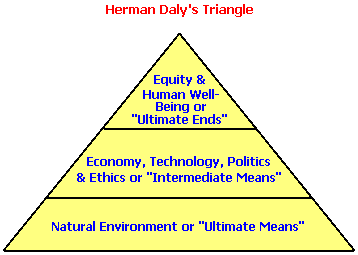
Daly's Triangle emphasizes that the natural environment is the precondition for human life. It implies that the current threats to our natural capital inevitably jeopardize our desires for a good quality of life shared by all. It is a framework which illustrates that the economy is not an end onto itself, but serves as a vehicle for achieving ultimate ends. The economy succeeds to the extent that it conserves and restores ultimate means (the environment), and enables us to achieve ultimate ends (well-being).
In this way, Daly's Triangle offers a context for other sustainability tools. For example, two key conceptual tools, the
and
are concerned with protecting and measuring the environment or ultimate means part of the Triangle. Likely, the environment dominates current sustainability thinking because it is the precondition for human life, and the least understood and respected part.
Tripartite model of anxiety & depression:
- General distress or negative affect (NA).
- Physiological hyperarousal (PH).
- Anhedonia or low positive affect (PA)
Tripartite model of neural control of movements:
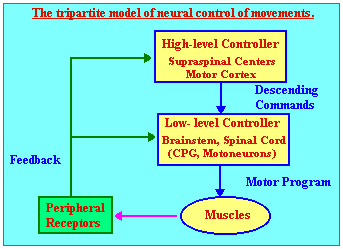
--- Modeling behavioral/voluntary control of breathing ---
Tripartite Model of Motivation for Achievement:
- Attitude-) or beliefs that people hold about themselves, their capabilities, and the factors that account for their outcomes.
- Drive- or the desire to attain an outcome based on the value people place on it.
- Strategy- or the techniques that people employ to gain the outcomes they desire.
Bruce W. Tuckman
3-part organizational teaching to Scientology:
Human beings are composed of three parts-
- The thetan (or spirit).
- The mind.
- The body.
The mind is also tripartite-
- An analytical mind.
- A reactive mind.
- A somatic mind.
- The analytical mind is a perfectly rational computer, but it drops out during periods of unconsciousness or any painful event.
- The reactive mind records painful events as "mental image pictures" called engrams, and recalls them in an associationist fashion that interferes with the analytical mind's computations.
- The somatic mind is responsible for reflexive, animal-like behaviors.
TA setting should be between 2 & 3 when using the E-meter (Electropsychometer).
Scientology's OT III (Operating Thetan) is said to be the beginning of an "Advanced Spiritual Technology".
CCHR, the Citizens Commission on Human Rights, is a front group operated by the Church of Scientology to oppose conventional mental health treatment, including use of Prozac for depression and Ritalin for attention deficit disorder. In a pamphlet called Psychiatry: Education's Ruin, CCHR urges concerned parents to write their elected representatives to demand:
- That the practice of psychology or psychiatry be declared illegal in schools or colleges.
- That the funding for all mental health programs, tests, research or administrative costs in schools be cut, and re-appropriated towards proven non-psychological/psychiatric teaching methods.
- That the government funding to mental health research institutes such as the U.S. National Institute of Mental Health be cut.
3 to 1 ratio analysis of the MG Taylor seven stages creative process:
| ONE of 3 | TWO of 3 |
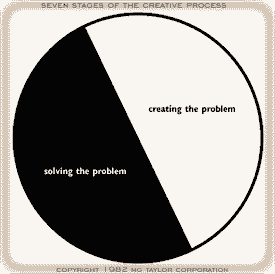 Bipartite Model |
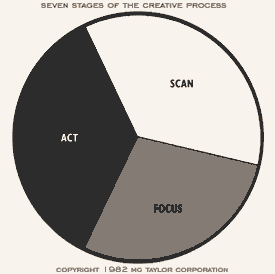 Tripartite Model |
| THREE of 3 | |
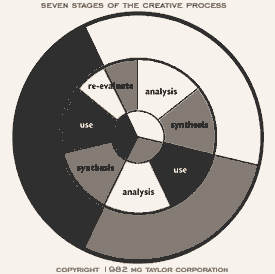 The First Recursion: The Septpartite Model |
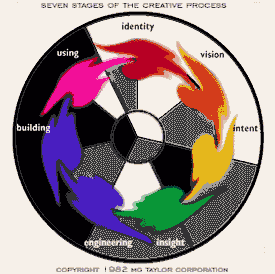 The Second Recursion: The Standard Model |
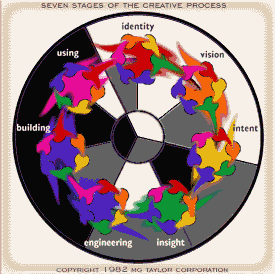 The Third Recursion |
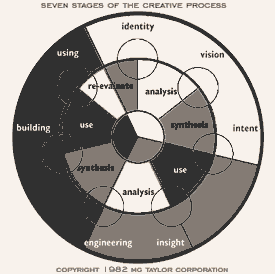 The Septpartite and Standard Models |
| ONE of 1 | The Fourth Recursion and Beyond...The full model of the Creative Process, as developed in 1982 contains yet a further recursion to the process to reinforce the idea that the Creative Process is extremely fractal. | |||||||||||||||||||||||||||||||||||||||||||||||||
3 (broadly stated) rival versions, referred to as the "Three R's" of epistemology:
- Religious revelation.
- Scientific rationalism.
- Postmodern relativism.
By Billy Grassie
3 colloquial notions of an attitude:
- Opinion, viewpoint, position, belief, reaction, evaluation, judgment, disposition, tendency, inclination.
- Striking a pose: an angle or slant on things - partiality and bias.
- Taking a firm and forthrightly articulated position.
3 types of biases that tend to creep into all self-report measures:
- Structural: depends on the format of, and items in, a questionnaire.
- Epistemological: People don't know how they really feel.
- Motivation: People, etc...
3 reasons why are we interested in attitudes:
- We want to *know* what's on people's minds per se.
- We want to be able to *predict* how they think and behave.
- We want to *change* how they think and behave.
Tripartite or 3-component or attitude structure model:
- Thinking- Cognitive (belief)
- Feeling- affective (moods, feelings, emotions, physiological changes)
- Doing- behavioral (behavior, or intentions to behave)
by Aiden P. Gregg
We may discern three theoretical generations in the evolution of activity theory:
- The first generation, centered around Lev Vygotsky (1896-1934), created the idea of mediation.
- The second generation of activity theory derived its inspiration largely from Alexei Leont'ev's work. In his famous example of "primeval collective hunt" Leont'ev (1981, p. 210-213) explicated the crucial difference between an individual action and a collective activity. The distinction between activity, action and operation became the basis of Leont'ev's three-level model of activity.
- The third generation of activity theory needs to develop conceptual tools to understand dialogue, multiple perspectives and voices, and networks of interacting activity systems.
Triadic sequence Example (from Haley, 1987):
- Father-Incompetent (Father upset or depressed, not functioning to capacity)
Child-Misbehaving (Child out of control or shows symptoms)
Mother-Incompetent (Mom can't deal with child, Dad gets involved) - Father-Competent (Dad deals with child effectively)
Child-Behaving (Child behaves well or "normally")
Mother-Competent (Mom deals with child and Dad competently, expects more from them) - Father-Incompetent (Dad upset or depressed……)
Cycle begins again
3 genetically independent dimensions of personality proposed by Dr. C. Robert Cloninger in June of 1987, as a systematic method for the clinical description and classification of personality variants:
- Novelty Seeking (behavioral activation) is modulated by the NT dopamine. It has the relevant stimuli as novelty, potential reward and the potential relief of monotony or punishment. The behavioral responses are exploratory pursuit, appetitive approach and active avoidance or escape.
- Harm Avoidance (behavioral inhibition) is modulated by serotonin. It has the relevant stimuli as conditioned signals for punishment, novelty or frustrative non-reward. The behavioral responses are passive avoidance and extinction of stimulus.
- Reward Dependence (behavioral maintenance) is modulated by norepinephrin. It has relevant stimuli as conditioned signals for reward or relief from punishment. The behavioral response is resistance to extinction of stimulus.
These 3 systems together integrate the overall activity of the CNS through time. The discipline of biorhythms describes this integration. The Physical(P), Emotional(E) and Intellectual(I) Cycles of Biorhythms correlate to the above 3 systems. The P-cycle is the DA system, the E-cycle is the 5-HT system and the I-cycle is the NE system. Thus we have a good picture of the basis of human behavior as the expression of the 3 major CNS neuromodulators interacting cyclically through time as the sum total of the integration of the 3 at any one point in time.
As the physical expression of the cellular components of the body are genetically determined, then their integration is also genetically determined. The cycles of each are such that they amplify and dampen each other according to the summation of each individual neuromodulator into an overall behavioral expression at any point in time. This is seen as a complex wave made up of the additions and subtractions of each individual wave according to the individual cycle; P(DA) cycles in 23 days, E(5-HT) cycles in 28 days and I(NE) cycles in 33 days.
Each (+) half and (-) half of the individual waves reflecting a cyclic surge and ebb of activity in each of the neuromodulator nerve cell loci. This is reflected in the cyclic changes in the relationships of the Solar System Interplanetary Magnetic field caused by the relative positions of the sun and planets as they move about each other.
--- The Japanese Journal of Developmental Psychology (2001, Vol.12) ---
(Various discussions on Dyadic/Triadic interactions)
Three "ought-to-be" goals of sound brain-based visual education:
- To teach an understanding of and respect for the functions of the right hemisphere of the brain.
- To encourage students to heavily utilize the functions of the right hemisphere as a foundation for disciplined artistic thinking.
- To focus on the integration and synchronization of all brain functions (both left and right) in ways that are characteristics of disciplined, creative artists.
Three Stage Healing Process by Dr. Rollin Becker D.O. which occur as the biodynamic and biokinetic forces are initiated within the heart of a fulcrum:
- The tissue fields move towards a state of balanced tension and a functional still-point. "It feels as if these energy fields and tissue elements are working their way, within their pattern, towards the point of balance for that pattern."
- The State of balance is attained. "A functioning still point, the potency, is reached at which time all motion apparently ceases, relatively speaking... When the pattern goes through the functioning still point, a change takes place within the potency. Something happens as a result of this change in the potency. This is the corrective phase of a treatment program."
- Motion is re-established. "Motion is again felt within the bioenergy fields and tissue elements. The pattern that unfolds is one that indicates a more normal pattern of functioning..."
http://www.craniosacral.co.uk/art4.htm
Triadic structures are associated with intelligence. Charles Peirce demonstrated that conscious events like language or symbol use have a fundamentally different logical structure than dyadic physical models. Charles Peirce modeled language as a triadic event. Inventing a graphical algebra to analyze the external forms of relations, Peirce demonstrated that triadic structures could not be constructed out of any arrangement of dyads; thus, the triad is a fundamental structure.
I propose a conjecture: if triads indicate intelligent activity, and if there are natural phenomena which are triadic (namely, the non-computational processes of the human mind), then the conclusion that such natural processes are the sign of an intelligent designer is not an unmotivated proposition.
Date of Origination: (approx.) Sunday, 31st December 2000... 11:18 PM
Posted Update: Thursay, 24th May 2018... 7:00 AM
Herb O. Buckland
herbobuckland@hotmail.com
